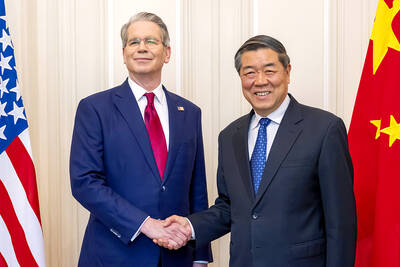Integrated circuit designer Faraday Technology Corp (智原科技) on Thursday reported a profit for last quarter that trumped market expectations, reflecting the firm’s progress in transforming its business.
Net income for the final quarter of last year rose 30.5 percent year-on-year to NT$41 million (US$1.39 million), with earnings per share (EPS) of NT$0.17, from NT$31 million, or NT$0.12 per share, the company’s financial statement showed.
While fourth-quarter revenue fell 25.8 percent annually to NT$1.13 billion, gross margin increased to a 10-year high of 54.6 percent from 44.2 percent, the company said.
The improvement in margin reflects higher sales in the high-margin silicon intellectual property rights and non-recurring engineering (NRE) segments, compared with the low-margin application-specific integrated circuit (ASIC) design business.
NRE revenue last quarter rose 6 percent quarter-on-quarter to NT$160 million, driven by strong “design wins” for new applications, including artificial intelligence (AI), blockchain, high-performance computing (HPC) and the Internet of Things, as well as 3D sensing and cryptocurrencies, Faraday said in an e-mailed statement.
In the semiconductor industry, a “design win” indicates that a company has designed a chip or product in a way that will lead to large sales volume.
Overall, Faraday said that niche products remained the company’s focus last quarter, accounting for 46 percent of its total revenue.
“Through strategic transformation, the influence of commodity [products] to the company’s operations last year gradually diminished and was superseded by niche products with high entry barrier and a long life cycle,” Faraday said in the statement.
Despite lower revenue contribution from commodity products, the firm’s overall revenue last year grew 1.6 percent to NT$5.34 billion from NT$5.26 billion a year earlier, with EPS rising to NT$3.4 from NT$1.14, it said.
“Faraday’s strategic transformation was in place last year. As a result, the number of new NRE projects increased significantly,”
the company said.
“With a focus on high-value products, Faraday also successfully enhanced revenue quality and its product mix, while moving itself out of the commodity segment,” it added.
The firm’s low-margin ASIC business last quarter accounted for 65.9 percent of its revenue, but Faraday president Steve Wang (王國雍) said the company aims to maintain its gross margin at 50 percent this quarter by doubling revenue contribution from the NRE segment from a year earlier.
However, overall revenue might still decline by a single-digit percentage from last quarter due to seasonal factors, Wang said.
As the ASIC market is expected to grow with booming AI and HPC trends, and the company is working to move toward niche markets, Wang said that Faraday is likely to see its business grow quarter-on-quarter after hitting a trough this quarter, and its gross margin should stay above 50 percent.

Jensen Huang (黃仁勳), founder and CEO of US-based artificial intelligence chip designer Nvidia Corp and Taiwan Semiconductor Manufacturing Co (TSMC, 台積電) on Friday celebrated the first Nvidia Blackwell wafer produced on US soil. Huang visited TSMC’s advanced wafer fab in the US state of Arizona and joined the Taiwanese chipmaker’s executives to witness the efforts to “build the infrastructure that powers the world’s AI factories, right here in America,” Nvidia said in a statement. At the event, Huang joined Y.L. Wang (王英郎), vice president of operations at TSMC, in signing their names on the Blackwell wafer to

AI BOOST: Although Taiwan’s reliance on Chinese rare earth elements is limited, it could face indirect impacts from supply issues and price volatility, an economist said DBS Bank Ltd (星展銀行) has sharply raised its forecast for Taiwan’s economic growth this year to 5.6 percent, citing stronger-than-expected exports and investment linked to artificial intelligence (AI), as it said that the current momentum could peak soon. The acceleration of the global AI race has fueled a surge in Taiwan’s AI-related capital spending and exports of information and communications technology (ICT) products, which have been key drivers of growth this year. “We have revised our GDP forecast for Taiwan upward to 5.6 percent from 4 percent, an upgrade that mainly reflects stronger-than-expected AI-related exports and investment in the third

France cannot afford to ignore the third credit-rating reduction in less than a year, French Minister of Finance Roland Lescure said. “Three agencies have downgraded us and we can’t ignore this cloud,” he told Franceinfo on Saturday, speaking just hours after S&P lowered his country’s credit rating to “A+” from “AA-” in an unscheduled move. “Fundamentally, it’s an additional cloud to a weather forecast that was already pretty gray. It’s a call for lucidity and responsibility,” he said, adding that this is “a call to be serious.” The credit assessor’s move means France has lost its double-A rating at two of the

RARE EARTHS: The call between the US Treasury Secretary and his Chinese counterpart came as Washington sought to rally G7 partners in response to China’s export controls China and the US on Saturday agreed to conduct another round of trade negotiations in the coming week, as the world’s two biggest economies seek to avoid another damaging tit-for-tat tariff battle. Beijing last week announced sweeping controls on the critical rare earths industry, prompting US President Donald Trump to threaten 100 percent tariffs on imports from China in retaliation. Trump had also threatened to cancel his expected meeting with Chinese President Xi Jinping (習近平) in South Korea later this month on the sidelines of the APEC summit. In the latest indication of efforts to resolve their dispute, Chinese state media reported that